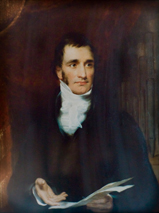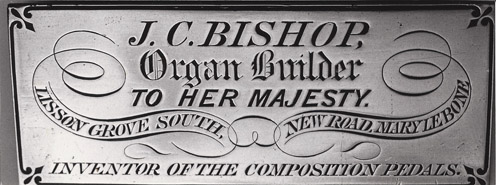The history of London and Ipswich based organ builders Bishop and Sons
 Founded in 1795, James Chapman Bishop’s first workshops were at York buildings in Saint Marylebone. He soon became well established and took on the premises of 250 Marylebone Road as his workshops.
Founded in 1795, James Chapman Bishop’s first workshops were at York buildings in Saint Marylebone. He soon became well established and took on the premises of 250 Marylebone Road as his workshops.

J. C. Bishop quickly built a good reputation and became widely known as a master organbuilder whose attention to detail and expert knowledge, combined with ingenuity and craftsmanship, produced some of the finest English organs of the nineteenth century.
The master organbuilder insisted from the start of his career that his house used only the finest materials and best quality resources in its manufactory and that this rule was not compromised for expedience or financial economy.
James Bishop was responsible for inventing some of the features that we take for granted in organbuilding today, namely the anti-concussion valve to provide steady wind, the Clarrabella stop and the composition pedals.
Charles Augustus Bishop and George Speechley Bishop were J. C. Bishop’s sons, both of whom were trained as organbuilders and followed in their father's footsteps and ran the firm alongside him. Charles was more involved in the running of the firm, taking on many of the responsibilities at the workshops while his father was travelling on firm’s business. After his father’s death in 1854, responsibility for the firm fell largely into Charles’ hands, and indeed he was responsible for the partnerships with Starr and Richardson. George decided to spend less time at the workshops and gave his time only when needed.
Charles Kenwrick Kenelm Bishop was Charles Augustus’ son, who was put to task in the firm at every opportunity from a young age, he was much loved by all of the men and became an excellently skilled young organbuilder. C. K. K. was a man of great vision who sadly became ill from a young age and so didn’t live to fulfil his dreams and potential. However in his time at the heart of the firm the young Charles was able to follow in his grandfather's footsteps showing innovation and attention to detail. The firm saw a new era of ingenuity and creativity during C. K. K.’s time with the registration of new patents and improvement of techniques and practices, a remarkable achievement in such a small span of time.
Edward Hadlow Suggate was an organbuilder at Bishop and Son during Charles K. K. Bishop’s time. As young Charles became too ill to administrate the firm, E. H. Suggate saw the need for a certain future for the firm and was able to raise the money necessary to purchase the business and its assets. Mr Suggate subsequently was able to take over the entire management of the firm but was keen to keep Charles involved as much as possible. Indeed Charles was constantly present in the workshop, both in the offices and at the bench. When C. K. K.Bishop died, Mr Suggate insisted upon ensuring financial support for his widow and family.
 During Edward Hadlow Suggate’s time as Principal of the firm, Bishop and Son saw some of the most dramatic changes in organbuilding. Indeed he was to oversee its progress through the end of the nineteenth century and its journey through the beginning of the twentieth, this is by many considered to be one of the most important periods of the trade’s history. In his time Mr Suggate was responsible for the purchasing of a new large works as the firm expanded to Ipswich, and he completely re-tooled twice.
During Edward Hadlow Suggate’s time as Principal of the firm, Bishop and Son saw some of the most dramatic changes in organbuilding. Indeed he was to oversee its progress through the end of the nineteenth century and its journey through the beginning of the twentieth, this is by many considered to be one of the most important periods of the trade’s history. In his time Mr Suggate was responsible for the purchasing of a new large works as the firm expanded to Ipswich, and he completely re-tooled twice.
Mr Suggate was keen to maintain the firm's tradition of best quality what ever the cost and was equally as keen to advance as far as possible the techniques and output of the firm. After the loss during the Great War of his son Eric Suggate, a gifted young man and a brilliant engineer who was responsible for the firm’s electric and hydraulic blowing achievements up to the war, Mr Suggate worked closely with his work's manager Mr Holt to develop any area of the trade it was possible to, and in the 1920’s Bishop and Son was responsible for achievements in developing the electric action which is still remarkable today. Indeed the techniques developed by them were not used by some other firms until decades later and are still in use today, the late R. A. Williams (Stero) basing much of his electrical equipment on the firm’s designs.
Mr Suggate took a keen interest in the building and finishing of every organ the firm worked on and would attend to the finishing himself. This attentiveness produced some of the most musical instruments of the period and was passed on to Mr Suggate’s daughter. Hilda Mary Suggate ran the firm after her father’s death. She was a shrewd businesswoman like her father before her and shared his compassion for the staff as well as the work they carried out. In the last half a century, Bishop and Son has continued to develop the technology and design of instruments with care and pride. It follows closely in the traditions of predecessors while looking forward to the future with continued research and development of work – within its workshops can be seen equipment and tooling that has been here for over 200 years together with new machinery and tooling. This helps it to stay at the leading edge of the market for good quality British organ building.
To find out more and contact the company visit www.bishopandsonpipeorgans.co.uk and www.bishopandsonipswich.co.uk













